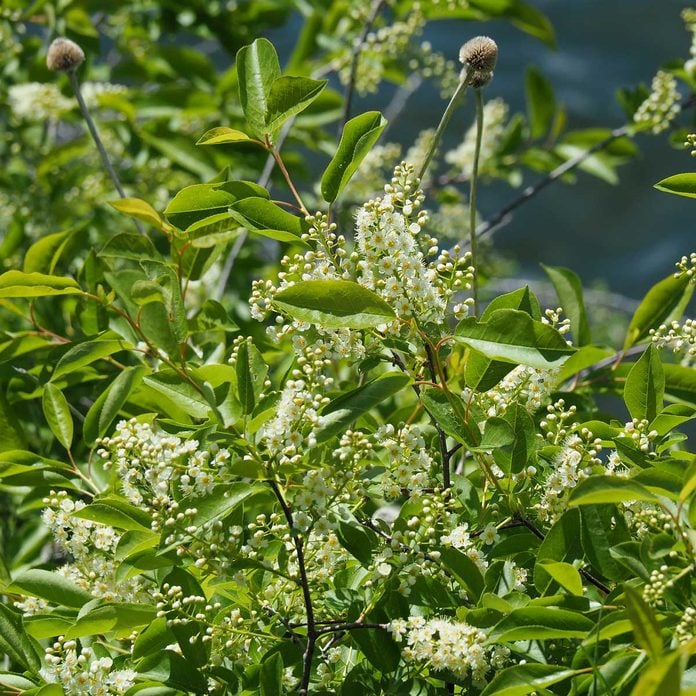
‘Canada Red’ Chokecherry
Chokecherry (Prunus virginiana) is a common suckering, fast-growing tree usually seen as a large, multi-stemmed shrub in the wild. ‘Canada Red’ is an ornamental cultivar that can be grown as a large multi-stem shrub or single-stem tree. Moreover, ‘Canada Red’ has another feature for the home landscape: the leaves start out green but turn to burgundy by the start of summer. Add to that the sweetly scented spring flowers and pretty cherry bark and you have a star performer. ‘Canada Red’ grows 3 to 4 feet a year and reaches about 30 feet tall. Best in USDA Hardiness Zones 2 through 10.

Elderberry
Out in the wild, elderberry (Sambucus nigra) is a nondescript plant except when it puts forth large clusters of white flowers in early summer, later followed by dark berries. Newer cultivars have been developed for the residential landscape, featuring burgundy or chartreuse, finely-dissected leaves that mimic Japanese maple. However, elderberry grows much faster than Japanese maple, with cultivars putting on 12 to 18 inches of growth annually. Cultivars and their mature heights include: Black Lace (6 to 8 feet tall); Black Beauty (10 feet tall); Lemony Lace (3 to 5 feet tall). Best in Zones 3 through 7.

Joe Pye Weed
Joe Pye weed (Eutrochium purpureum) is a highly adaptable perennial that grows in sun or part shade, accepts a range of soils including heavy clay, and resists deer browsing. The species grows 5 to 7 feet tall, but it can be kept shorter by cutting stems by a third in early summer. A shorter cultivar, ‘Little Red’, is just four feet tall. Joe Pye weed features large, dusty-pink flowers that attract butterflies. You may want to deadhead the flowers to keep this vigorous-growing plant from self-seeding. Zones 4–9.

Mexican Sunflower
This tall, bushy annual grows four to six feet tall and flowers best on lean soils that don’t promote excess foliage. It’s also drought tolerant. As for aesthetics, Mexican sunflower is highlighted by bright orange, daisylike flowers from midsummer to frost. ‘Yellow Torch’ offers apricot yellow-orange blooms, while ‘Fiesta del Sol’ (3 feet tall) and ‘Goldfinger’ (24 to 30 inches tall) are more compact. Deadhead regularly to encourage new blooms, but be sure to let some go to seed to feed the birds and reseed a new batch of Mexican sunflower for next year.

Red-Twig Dogwood
Red-twig dogwood (Cornus sericea), also called red osier dogwood, is a rapidly growing, tough shrub that reaches 6 to 9 feet tall, 8 to 12 feet wide. It is easily kept in check with annual pruning. It’s best to remove a few older stems annually because the newest growth has the most vivid color in winter. Along with the colorful stems for winter interest, red-twig dogwood offers fragrant white flower clusters in late spring and bird-attracting white fruit drupes in fall. Red-twig dogwood takes various soils including constantly moist. Zones 3–8.

Quaking Aspen
As a member of the poplar family, quaking aspen (Populus tremuloides) is indeed a fast-growing tree for your yard, adding 2 feet or more of height annually. It tops out at 40 to 50 feet but tends to send up new shoots from its roots to eventually form colonies. That’s fitting because with greenish white to cream bark and golden yellow fall foliage, aspen looks really good in clumps or groves. Incidentally, the popular names, quaking aspen and trembling aspen, refer to the leaves quaking or trembling in the slightest breeze, providing a pleasant sound with a psychologically cooling effect. Zones 2–6.

Smoketree
Smoketree (Cotinus coggygria) is a multi-stemmed small tree that gets its name from the large, airy flower clusters that appear in midsummer and look like puffs of smoke. Growing 10 to 15 feet tall, smoketree also boasts attractive foliage. And it fills out a landscape beautifully. There are a number of popular cultivars including ‘Royal Purple’, with purple foliage turning scarlet in fall, and Golden Spirit, featuring chartreuse foliage that takes on orange and red hues in fall. Zones 5–8.

Spider Flower
Spider flower (Cleome hassleriana) is an old-time favorite that grows quickly from seed and can reach six feet tall. (Smaller cultivars are only 18 to 24 inches.) Once in the garden, this self-seeding annual will come back again and again, although future generations may have flowers of a different hue than the mother plant. The spiderlike flowers make your garden pop with pink, rose, purple and white. Plant spider flower in groups to give quick cover that flowers from early summer until frost.

Zinnia
If you want butterflies to help increase your curb appeal, zinnia is one of the annuals that should be at the top of your list. The taller varieties are especially appealing because they have the size and presence to really stand out. And with a range of colors — pink, yellow, orange, red and even lime — there’s a zinnia to please every gardener. Easily grown in place from seed, they’ll reach four feet tall by midsummer and bloom continually until frost. Leave the last flowers of the season in place to feed the birds.